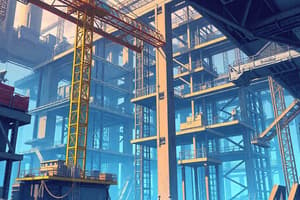Podcast
Questions and Answers
Which factor most significantly affects the compressive strength and durability of concrete?
Which factor most significantly affects the compressive strength and durability of concrete?
- The color of the cement.
- The type of aggregates used.
- The water-cement ratio. (correct)
- The brand of Portland cement.
What is the primary reason for applying protective coatings like galvanization to steel used in construction?
What is the primary reason for applying protective coatings like galvanization to steel used in construction?
- To prevent corrosion. (correct)
- To improve its weldability.
- To reduce its weight.
- To increase its tensile strength.
Why are engineered wood products like plywood and OSB (Oriented Strand Board) often preferred over solid wood in construction?
Why are engineered wood products like plywood and OSB (Oriented Strand Board) often preferred over solid wood in construction?
- They are easier to install.
- They offer improved strength and dimensional stability. (correct)
- They are naturally fire-resistant.
- They are less expensive.
Which of the following is the most critical consideration when using masonry in construction to ensure structural integrity?
Which of the following is the most critical consideration when using masonry in construction to ensure structural integrity?
What property of polymers makes them particularly useful for piping in construction?
What property of polymers makes them particularly useful for piping in construction?
What is the primary purpose of using Low-E (low-emissivity) coatings on glass in modern building construction?
What is the primary purpose of using Low-E (low-emissivity) coatings on glass in modern building construction?
How does Building Information Modeling (BIM) primarily contribute to efficiency in modern construction projects?
How does Building Information Modeling (BIM) primarily contribute to efficiency in modern construction projects?
Why is material testing a critical step in construction?
Why is material testing a critical step in construction?
Which material property is most indicative of a material's ability to provide insulation?
Which material property is most indicative of a material's ability to provide insulation?
What is the main goal of using sustainable materials in construction?
What is the main goal of using sustainable materials in construction?
Flashcards
Building Materials
Building Materials
Substances used for constructing buildings and infrastructure.
Construction Techniques
Construction Techniques
Methods and processes used to assemble buildings and infrastructure.
Material Testing Methods
Material Testing Methods
Procedures to determine properties/performance of building materials.
Industry Standards
Industry Standards
Signup and view all the flashcards
Concrete
Concrete
Signup and view all the flashcards
Steel
Steel
Signup and view all the flashcards
Wood
Wood
Signup and view all the flashcards
Masonry
Masonry
Signup and view all the flashcards
Polymers
Polymers
Signup and view all the flashcards
Construction Techniques
Construction Techniques
Signup and view all the flashcards
Study Notes
- Building materials are substances used for construction
- Construction techniques refer to the methods and processes used to assemble buildings and infrastructure
- Material testing methods are standardized procedures used to determine the properties and performance of building materials
- Industry standards are guidelines and specifications established by organizations to ensure quality, safety, and uniformity in the construction industry
Types of Building Materials
- Concrete is a composite material made from cement, aggregates, and water, widely used for its strength and durability
- Steel is an alloy of iron and carbon, offering high tensile strength and used in structural frameworks and reinforcement
- Wood is a natural material used for framing, sheathing, and finishing, valued for its renewability and workability
- Masonry includes bricks, stones, and concrete blocks, used for walls, foundations, and pavements
- Polymers are synthetic materials such as plastics and composites, used for insulation, cladding, and piping
- Glass is a transparent material used for windows, curtain walls, and insulation
Concrete
- Concrete is a mixture of cement, aggregates (sand and gravel), and water, which hardens over time through a process called hydration
- Different types of cement, such as Portland cement, are used depending on the application and desired properties
- Aggregates provide bulk and influence the concrete's strength, durability, and workability
- Water is essential for the hydration process, and the water-cement ratio affects the concrete's strength and durability
- Admixtures are chemical additives that modify the properties of concrete, such as workability, setting time, and durability
- Reinforcement, typically steel bars or mesh, is embedded in concrete to increase its tensile strength, creating reinforced concrete
- Concrete is used in foundations, walls, columns, beams, slabs, and pavements due to its compressive strength and versatility
Steel
- Steel is an alloy of iron and carbon, with small amounts of other elements to enhance its properties
- Carbon content affects steel's strength and ductility; higher carbon content increases strength but reduces ductility
- Steel is used in construction for its high tensile strength, allowing it to withstand significant pulling forces
- Structural steel is available in various shapes, such as I-beams, channels, and angles, used for framing buildings and bridges
- Reinforcing steel (rebar) is used in concrete to provide tensile strength and improve the overall structural integrity
- Steel is susceptible to corrosion, so protective coatings like paint or galvanization are often applied to prevent rust
- Steel is used in high-rise buildings, bridges, and other structures that require high strength and durability, such as skyscrapers
- Steel production involves melting iron ore and other materials in a furnace, followed by shaping and heat treatment processes
- Common types of steel used in construction include carbon steel, high-strength low-alloy steel, and stainless steel
Wood
- Wood is a natural, renewable resource used in construction for framing, sheathing, and finishing
- Softwoods come from coniferous trees (e.g., pine, fir) and are typically used for framing and sheathing
- Hardwoods come from deciduous trees (e.g., oak, maple) and are used for flooring, cabinetry, and decorative elements
- Wood is graded based on its strength, appearance, and freedom from defects, influencing its suitability for different applications
- Wood is susceptible to decay, insects, and fire, so preservation treatments and fire retardants are often applied
- Engineered wood products, such as plywood, oriented strand board (OSB), and laminated veneer lumber (LVL), offer improved strength and dimensional stability compared to solid wood
- Wood is used in residential construction for framing walls, floors, and roofs, as well as for interior finishes and exterior cladding
- Sustainable forestry practices are essential for ensuring the long-term availability of wood as a building material
- Wood construction techniques include timber framing, platform framing, and balloon framing, each with its advantages and limitations
Masonry
- Masonry includes bricks, stones, concrete blocks, and other similar units held together with mortar
- Bricks are made from clay and fired in a kiln, providing durability and fire resistance
- Stones are natural materials quarried and shaped for use in walls, foundations, and pavements
- Concrete blocks are made from concrete and used for constructing walls and foundations
- Mortar is a mixture of cement, sand, and water used to bond masonry units together
- Masonry is used in walls, foundations, chimneys, and pavements, providing structural support and aesthetic appeal
- Different bonding patterns, such as running bond, English bond, and Flemish bond, affect the strength and appearance of masonry walls
- Masonry construction requires skilled labor to ensure proper alignment, levelness, and mortar application
- Masonry is durable, fire-resistant, and can provide thermal mass, helping to regulate indoor temperatures
Polymers
- Polymers, also known as plastics, are synthetic materials made from long chains of repeating units called monomers
- Polymers are used in construction for insulation, cladding, piping, and adhesives, offering versatility and durability
- Different types of polymers, such as polyvinyl chloride (PVC), polyethylene (PE), and polystyrene (PS), have varying properties and applications
- Polymers can be molded, extruded, or cast into various shapes and forms, making them suitable for diverse construction needs
- Polymers are lightweight, corrosion-resistant, and can be engineered to have specific properties, such as flexibility or rigidity
- Polymer-based insulation materials, such as expanded polystyrene (EPS) and polyurethane foam, provide thermal resistance and reduce energy consumption
- Polymer-based cladding materials, such as vinyl siding and composite panels, offer weather protection and aesthetic appeal
- Polymer pipes are used for water supply, drainage, and sewage systems due to their corrosion resistance and ease of installation
- Sustainable polymers, made from renewable resources or recycled materials, are gaining popularity in construction to reduce environmental impact
Glass
- Glass is a transparent material made from silica, soda ash, and lime, used for windows, curtain walls, and insulation
- Glass is used in construction for windows, doors, skylights, and curtain walls, allowing natural light to enter buildings
- Different types of glass, such as float glass, tempered glass, and laminated glass, have varying properties and applications
- Float glass is the standard type of glass used for windows, offering good clarity and flatness
- Tempered glass is heat-treated to increase its strength and shatter resistance, making it safer for use in doors and shower enclosures
- Laminated glass consists of two or more layers of glass bonded together with a plastic interlayer, providing enhanced safety and security
- Insulating glass units (IGUs) consist of two or more panes of glass separated by an air space, providing thermal insulation and reducing energy consumption
- Glass can be coated with reflective orLow-E (low-emissivity) coatings to control solar heat gain and reduce energy costs
- Glass is recyclable and can be used in the production of new glass products, reducing the need for raw materials
Construction Techniques
- Construction techniques encompass the methods and processes used to assemble buildings and infrastructure
- Traditional construction techniques include masonry construction, timber framing, and cast-in-place concrete
- Modern construction techniques include prefabrication, modular construction, and the use of advanced materials and equipment
- Prefabrication involves manufacturing building components off-site and then assembling them on-site, reducing construction time and waste
- Modular construction involves building entire sections of a building in a factory and then transporting them to the site for assembly
- Building Information Modeling (BIM) is a digital representation of a building that facilitates collaboration and coordination among project stakeholders
- Lean construction principles focus on minimizing waste and maximizing efficiency throughout the construction process
- Green building practices aim to reduce the environmental impact of construction by using sustainable materials and energy-efficient designs
- Safety is a critical consideration in all construction techniques, with regulations and procedures in place to protect workers and the public
Material Testing Methods
- Material testing methods are standardized procedures used to determine the properties and performance of building materials
- Destructive testing involves subjecting a material to stress until it fails, measuring its strength, ductility, and other properties
- Non-destructive testing involves evaluating a material's properties without causing damage, using methods such as ultrasonic testing and radiography
- Common material tests include compression tests, tensile tests, flexural tests, and impact tests
- Compression tests measure a material's resistance to crushing forces, important for concrete and masonry
- Tensile tests measure a material's resistance to pulling forces, important for steel and wood
- Flexural tests measure a material's resistance to bending forces, important for beams and slabs
- Impact tests measure a material's resistance to sudden impacts, important for materials used in collision-prone areas
- Material testing is essential for ensuring that building materials meet specified standards and perform as expected in service
Properties of Materials
- Properties of materials determine their suitability for specific construction applications
- Strength is a material's ability to resist deformation or failure under load, including compressive strength, tensile strength, and shear strength
- Durability is a material's ability to withstand weathering, abrasion, and other environmental factors over time
- Workability is a material's ease of placement, shaping, and finishing, important for concrete, mortar, and wood
- Thermal conductivity is a material's ability to conduct heat, affecting its suitability for insulation
- Fire resistance is a material's ability to withstand fire and prevent its spread, important for structural components and fireproofing materials
- Density is a material's mass per unit volume, affecting its weight and structural performance
- Porosity is a material's void space, affecting its permeability, water absorption, and freeze-thaw resistance
- Creep is a material's tendency to deform slowly under sustained load
- Modulus of elasticity is a measure of a material's stiffness or resistance to deformation under stress
Sustainable Materials
- Sustainable materials are those that have a lower environmental impact than conventional materials
- Renewable materials are derived from sources that can be replenished, such as wood from sustainably managed forests or bamboo
- Recycled materials are made from waste products, reducing the need for raw materials and diverting waste from landfills
- Locally sourced materials reduce transportation costs and emissions, supporting local economies
- Durable materials last longer and require less frequent replacement, reducing life-cycle costs and environmental impacts
- Materials with low embodied energy require less energy to produce, transport, and install
- Materials with low volatile organic compound (VOC) emissions improve indoor air quality
- Examples of sustainable building materials include bamboo, reclaimed wood, recycled concrete, and natural insulation
- Life-cycle assessment (LCA) is a method for evaluating the environmental impacts of a material or product throughout its life cycle, from raw material extraction to disposal
Industry Standards
- Industry standards are guidelines and specifications established by organizations to ensure quality, safety, and uniformity in the construction industry
- Standards are developed by organizations such as ASTM International, the American Concrete Institute (ACI), and the American Institute of Steel Construction (AISC)
- Standards cover a wide range of topics, including material properties, testing methods, design procedures, and construction practices
- Compliance with industry standards is often required by building codes and regulations
- Standards provide a common basis for communication and collaboration among project stakeholders
- Standards help to ensure that buildings and infrastructure are safe, durable, and perform as expected
- Standards are updated periodically to reflect advances in technology and changes in industry practices
- Certification programs verify that products and services meet specified standards
- Industry standards promote innovation by encouraging the development of new materials and technologies
Studying That Suits You
Use AI to generate personalized quizzes and flashcards to suit your learning preferences.




